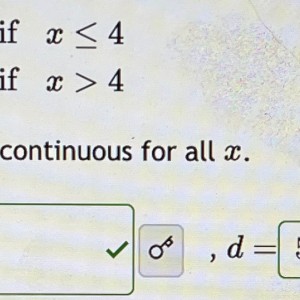Answer is done,
The answer is done, but I just need a detailed step-by-step how to get there. I'm still confused. Please show me step-by-step.
Answer
First note that $f$ has to be continuous. Hence we should have
\[\lim_{x\rightarrow 4^-}f(x)=\lim_{x\rightarrow 4^+}f(x) \Rightarrow c(4)^2=10-4d.\]
Thus
\[16c=10-4d. (1)\]
For $x< 4$, we have
\[f'(x)=2cx \Rightarrow \lim_{x\rightarrow 4^-}f'(x)=2c(4)=8c.\]
For $x>4$ we have
\[f'(x)=-d \Rightarrow \lim_{x\rightarrow 4^+}f'(x)=-d.\]
For $f'$ to be continuous, we should have
\[\lim_{x\rightarrow 4^-}f'(x)=\lim_{x\rightarrow 4^+}f'(x) \Rightarrow 8c=-d.\]
Thus
\[8c=-d. (2)\]
Solving the symstem of equations (1) and (2), we have
\[16c=10-4d, 16c=-2d \Rightarrow 10-4d=-2d\]
\[10=2d \Rightarrow d=5. \]
Also
\[16c=-2(5)=-10. \Rightarrow c=-\frac{-10}{16}=-\frac{5}{8}.\]
-
Thank you for the tip.
- answered
- 1497 views
- $3.00
Related Questions
- Does $\lim_{(x,y)\rightarrow (0,0)}\frac{(x^2-y^2) \cos (x+y)}{x^2+y^2}$ exists?
- Parametric, Polar, and Vector-Valued Equations for Kav10
- Find $\lim _{x \rightarrow 0} x^{x}$
- Calculate the following, if it exists: $\int_{0}^{1} x^a(lnx)^mdx$ , where $a > -1$ and $m$ is a nonnegative integer.
- Calculus Integral Questins
- Find $\int \sec^2 x \tan x dx$
- Are my answers correct
- Show that the MLE for $\sum_{i=1}^{n}\left(\ln{2x_i} - 2\ln{\lambda} - \left(\frac{x_i}{\lambda}\right)^2\right)$ is $\hat{\lambda} = \sqrt{\sum_{i=1}^{n}\frac{x_i^2}{n}}$.

